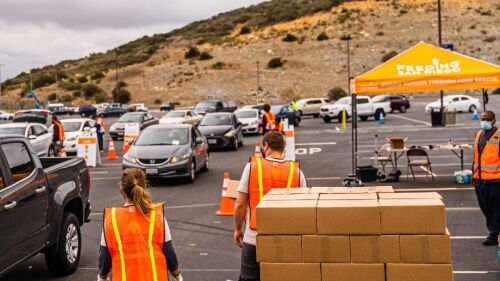Today, we talk about hiking — and there’s no way to do this without The Canyoneers, a group of volunteer naturalists leading free, guided hikes through San Diego County’s diverse trails since 1973.
The Canyoneers are part of the San Diego Natural History Museum, inviting locals to trek annually during prime hiking season from September-June. The 2022-2023 season starts this Sun., Sept. 18, and marks a milestone: The group’s 50th anniversary highlighting the gorgeous trails + biodiversity of San Diego County. 🏞️
We spoke to Canyoneers president John Ploetz about the group’s history + good work, must-see hiking spots, trekking tips, and why it’s important to care about the preservation of our region’s wide open spaces. Lace up those sneaks — let’s get outside. 🥾
Q: Who are The Canyoneers?
A: The Canyoneers are an outreach program of the San Diego Natural History Museum. Next year — 2023 — will be our 50th anniversary.
Q: Can you give us a brief history of this longtime group?
A: This is a healthy, all-volunteer organization that grew out of a group of people who worked at the museum — either as staff or volunteers — who got organized out of an attempt to pave Florida Canyon and turn it into a parking lot.
There were a lot of native plants and habitats that were going to be destroyed, so they got organized. There was a very active woman who became the founder of our organization — Helen Chamlee Witham.
They saved the canyon and they started leading hikes to the site from the museum because they thought, ‘Here’s a living laboratory, right outside our door.’
Now there’s a Canyoneers hiking guide called “Coast to Cactus” — which is in the bookstores — with hikes that are all evaluated by how hard they are, how long they take, with little maps.
We’re all volunteers and we’ve been trained by the museum scientists and other local experts about the Kumeyaay history. We call ourselves “Citizen Scientists” — we’re not Ph.D. experts but we are capable of leading interpretive hikes.
For more history, visit The Canyoneers website, too.
Q: How many volunteers are currently part of The Canyoneers?
A: We have ~75 active members leading hikes — ~20 frequently leading — and ~140 total members.
Q: How many hikes will The Canyoneers lead during their upcoming 2022-2023 season?
A: There’s at least one every week; we’re going to do 60 this season starting Sun., Sept. 18, and going through June 2023. Our sponsor is Subaru and they do a lot for our program.
Q: How do locals sign up for these hikes?
A: It’s free and accessible. The best thing to do is pre-register on The Nat’s website, this way we can get an idea of how many people are coming and if we need more guides, we can put the word out to our people.
Q: What kind of hikes does the group lead?
A: We spend quite a bit of time picking the hikes each season; we try hard not to use the same hikes every year to shake it up a little bit both for us and for our repeat clients.
Our earlier hikes (September + October) will be closer to the coast where it’ll be cooler and as we get into the winter, we’ll go into the desert more and up into the Laguna Mountains. There’s a time of the year where it’s great to be at Palomar Mountain. We want to provide different levels of difficulty and we want these hikes to be family-friendly. There’s something for everybody.
Q: Name three of your personal favorite hikes in San Diego:
A: I really like Volcan Mountain by Julian; that’s a lovely hike. There’s a time of year when you see millions of wildflowers — California poppies and cream cups — as far as the eye can see. If you’re lucky and it’s real clear — probably more in the winter, after it rains — you can see Yuma, and the ocean, and into Mexico because you’re high enough, and that’s cool.
I like Torrey Pines — everybody does. It never gets old. There’s people that live their whole lives and never see anything like this. We’ve gone there with people from out of town and they’re like, ‘This is amazing.’
I really like the desert hikes; I like Anza-Borrego Desert State Park and fortunately, so does my wife.
Q: If you’re a local joining a Canyoneer hike, what should you bring in your daypack?
A: No. 1 is water — especially on a longer hike. Snacks, for some calories. These are not hikes that are moving at a fast pace and we will stop for breaks and have a snack. Trail mix, Power Bars, etc.
You’ll need sturdy hiking shoes — they don’t have to be mountain boots, but no flip-flops — and sun protection like a hat and sunscreen. It’s always good to be prepared for rain, so simple rain gear and depending on the weather, some kind of light sweater. Just the basics, be prepared for heat, cold, rain and keep yourself hydrated + nourished.
People may also want to bring a trekking pole for more stability.
Q: Describe San Diego’s hiking trails:
A: Right here, in our own backyard, a half a tank of gas gets you into all sorts of habitats — mountains, beach, ocean, desert. There’s nowhere else in the world that’s the size of San Diego County that has this kind of biodiversity.
There are hundreds of trails on public lands. Most of these places are free. I would point people to our book, “Coast to Cactus,” as a resource. It’s got 300 hikes, so it’s a good place to start.
There are hikes at the ocean, in the coastal sage scrub, in the foothills, the mountains, and desert.
Q: What are some native plants or animals that Canyoneers often spot on hikes — that the public also enjoys learning about?
A: Plants that are common on our hikes include toyon, lemonade berry, manzanita, sugar bush, white sage, black sage, chamise, California buckwheat, ceanothus, mountain mahogany, and the various oaks depending on the elevation.
In the desert we commonly see ocotillo, desert agave, cacti like prickly pear and cholla, and Mojave yucca. More than just reciting the names, we try to focus on how the Indigenous people used these plants for food, fiber, and medicine.
Seasonal wildflowers and flowering perennials can be found all over depending on rainfall and the season. And of course poison oak is very common and we always point it out to people as it looks different at different times of the year and in different habitats — ‘If you only learn one plant today…’
Animals are harder to spot because many of them are nocturnal. Unlike humans they lay low during the heat of the day.
We do see scat and tracks, and structures like wood rat nests, that give evidence of their presence and something to talk about. Birds are active but don’t always hold still for us. Canyoneers are familiar with native birds, and some Canyoneers are real expert birders. Snakes are not rare and it’s always a privilege to see one; not all are dangerous. We educate people about rattlesnakes and their important place in the ecosystem. They are venomous, of course, but not aggressive.
Q: Is there a local trail that Canyoneers would consider a “hidden gem”?
A: People who haven’t hiked for a while — like, maybe because of COVID — may not be aware of relatively new developments like the Coast to Crest Trail (CCT), a very ambitious project to create a hiking trail from Del Mar to Volcan Mountain north of Julian. There are still areas of private land where easements are needed, but there are segments of the trail that are outstanding.
The Santa Ysabel Open Space Preserve is certainly a gem. There is an east section and a west section, both along the CCT. The CCT coastal section that begins by the Del Mar Fairgrounds is also very special.
I could go on and on about San Diego County hikes; there are so many great ones The Pictograph Trail in Blair Valley (Anza-Borrego Desert State Park) — this one usually requires four-wheel-drive to get to the trailhead; the Big Laguna Loop starting at Penny Pines on the Sunrise Highway, a 10-mile loop (it could be made shorter) that is basically flat and leads to some spectacular views of the desert; Moonlight Canyon at Agua Caliente County Park, where you can end up with a dip in the thermal pools are just a few.
Some places (our seasonal waterfalls, Cowles Mountain) are overused and are sites where there are far too many rescues due to inexperienced people attempting them. These are iconic but I would encourage people to get out and find their own happy places.
Our “Coast to Cactus” book is a terrific guide. On our website are some great curated walks such as “Five Great Hikes for Kids” and “Ten Great Hikes for Fall.”
Q: Why do you love being a Canyoneer?
A: I enjoy being a Canyoneer for many reasons. We’re helping the museum and its mission; we’re educating + activating the people. And for personal satisfaction — I like to get out, I like to hike with friends. I’ve made so many great friends.
We hope that as people see the backcountry and have it interpreted, then they want to preserve it — then they get the importance of open space.
Q: How can locals sign up to volunteer as a Canyoneer?
A: We have a 10-week training class every fall that starts in September. There is a test. The procedure is that starting in the Spring — April or May — people sign up for the fall classes. Our newest fall class has 19 volunteers; they’ll do their 10 weeks and the weekend before Thanksgiving, they’ll have their graduation.
The expectation is that everyone in this new class will guide six hikes during the 2022-2023 season — less than one a month. The main thing that’s needed is that you like to hike already and that you’re a friendly, outgoing person.
🥾 The final leg
There you have it, San Diego — incredible local hiking knowledge from a group that sure knows their trails. Ploetz took the Canyoneers training + graduated in 2019 after going on hikes with the group for years.
Ploetz told us that he’s fascinated by the history of San Diego County’s trails — and he hopes to teach fellow hikers how these paths were walked by locals before us. Ploetz said it’s important to remember that the Kumeyaay lived off this land, relying on it for their food, medicine, clothing + shelter. He believes this connection to the past — the land, history, and people — is the key to engaging hikers today and teaching San Diegans how important it is to preserve our natural spaces. 🏞️


















